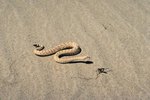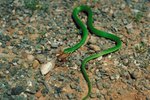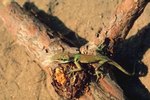
Pogona vitticeps is the most common type of bearded dragon found in home terrariums. This reptile's roots are in the woodlands and deserts of Australia, where he eats insects, flowers, fruit and small lizards. The differences between these guys basically are skin deep, mainly due to breeding and genetic mutations.
Dragon Colors
Generally, bearded dragons are brown, yellow, red, green or tan in color with some light patches of white or off-white. However, breeders selectively breed dragons to give the reptiles a more appealing or dramatic appearance. Dragons with high amounts of red coloring are more likely to produce red bearded dragons; the same is true of dragons with high levels of yellow coloring. Breeding yellow and red dragons often produces dragons with a golden color. Though they're difficult to find, some breeders have carefully bred dragons to produce blue, purple and black bearded dragons. A genetic disorder can affect coloring, too. Hypomelanistic, or hypo, dragons have reduced melanin, giving them a light or pastel color. Dragons with clear nails and almost no color at all are leucistic.
The Smooth Leatherback
Some bearded dragons have a gene mutation preventing their scales from fully developing. As a result these guys have more small scales, giving them a smooth look and feel. Selective breeding not only perpetuates the smooth finish, but also provides a variety of color options for this kind of dragon. Leatherbacks still can have spikes, some with most of their side spikes and others with very few spikes on the side.
Extra Smooth Leatherback: Silkback
Two leatherback dragons don't always make another leatherback; some of their offspring are so smooth, they're called silkback bearded dragons. These fellows have such tiny scales that their skin looks and feels almost as soft as silk. Unlike their leatherback relatives, silkbacks have no spikes and instead are covered in circular and oval shaped scales. Their skin is a little more delicate and can be sensitive to ultraviolet B rays and prone to dryness. About half the time, two leatherbacks will have more leatherbacks, 25 percent of the time they'll produce normal bearded dragons and 25 percent of the time they'll produce silkbacks. Like the leatherback, silkbacks are often bred to produce unusual colors.
Other Bearded Dragons
Australia is home to other species of bearded dragons. The pogona barbata lives in eastern Australia and grows to 24 inches. He likes dry wooded areas and enjoys climbing. Pogona henrylawsoni lives in the western and central parts of Queensland, preferring deserts. He grows to about a foot long and is active during the day, when he's usually climbing. The remaining bearded dragons are rare, so there's little information about their behavior. The small pogona microlepidota maxes out at 6 inches. Pogona minor minor lives in western or central Australia, in rocky areas and woodlands. He grows to between 14 and 18 inches. Western Australia is also home to the pogona minor minima, who also favors woodlands. He reaches 12 inches in length. Pogona minor mitchelli lives in northwestern Australia in desert and semi-tropical woodlands. He can reach 18 inches in length. Pogona nullarbor is found in the southern part of the continent, living in flat brush areas and reaching 14 inches.
References
Photo Credits
-
BananaStock/BananaStock/Getty Images




